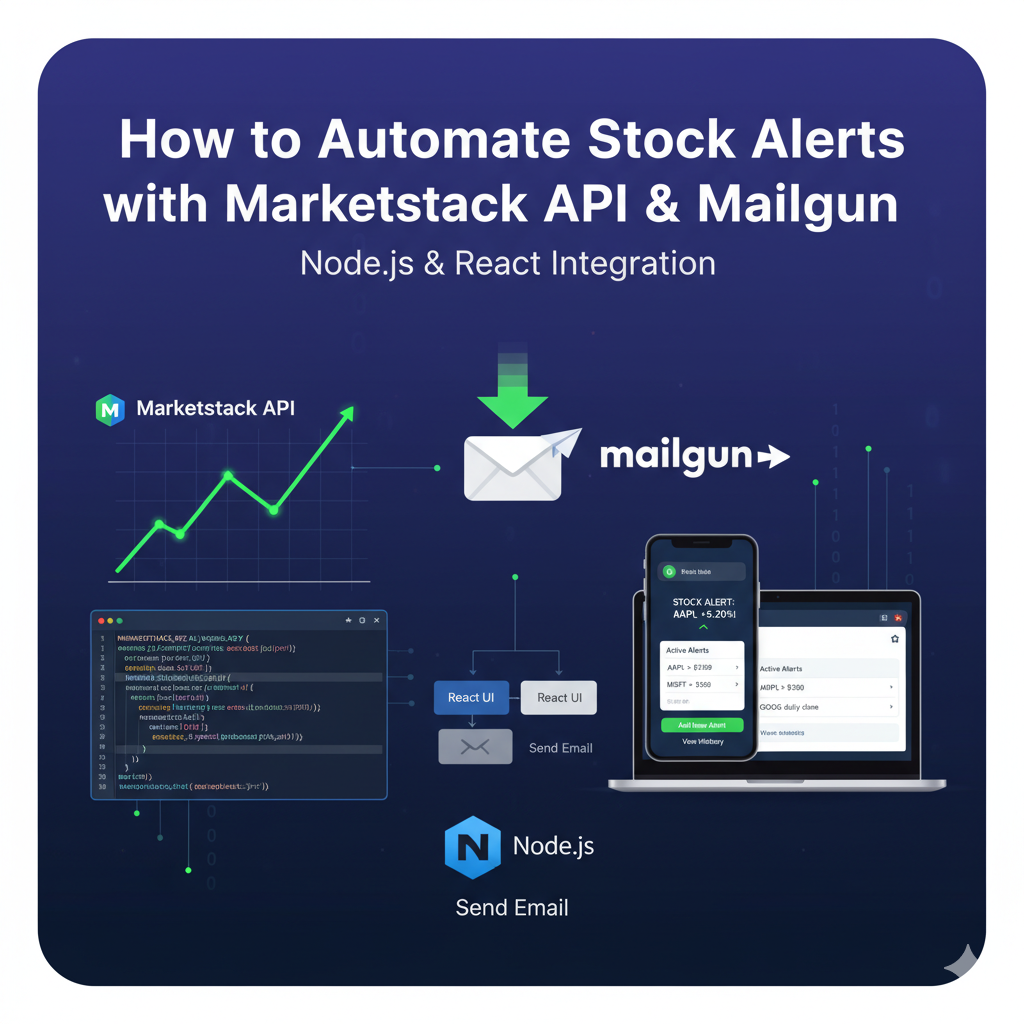Automated stock price notifications are essential tools for developers building financial applications that require timely, actionable insights. This article explores how to send stock price notifications using Node.js, and how to leverage Mailgun’s powerful email API service to deliver stock alert emails efficiently. The tutorial targets developers looking for straightforward implementation guidance and best practices to integrate reliable notification systems into their trading or portfolio platforms. By the end, readers will understand how to fetch stock price data, process alert conditions, and use Mailgun to send customized alert emails.
Why Send Stock Price Notifications with Node.js?
Node.js is an ideal choice for automated stock notification systems because of its non-blocking, event-driven architecture, which allows for quick real-time processing of financial data streams. Many stock market APIs output data requiring immediate analysis to determine if alerts should be sent. Node.js can handle API requests efficiently and trigger notifications based on specific conditions without lag, which is crucial for financial applications.
Introducing Mailgun for Stock Alert Emails
Mailgun is a developer-focused email delivery platform offering robust APIs to send transactional emails, such as stock price alerts, with high deliverability and scalability. It simplifies sending email notifications by handling complex SMTP processes, enabling developers to focus on the business logic of alerting rather than infrastructure.
Mailgun features include:
- Sending bulk or transactional emails via simple HTTP API.
- Detailed event tracking (opens, clicks, bounces).
- Easy integration with Node.js through official libraries.
- Free tier for developers starting out.
Step 1: Preparing Your Environment
Before coding, obtain API keys for the stock market data provider (like Marketstack, Alpha Vantage, or Finnhub) and Mailgun. Set up your Node.js project with necessary dependencies:
bash
npm init -y
npm install axios mailgun-js node-cron dotenv
Use dotenv to securely store your API keys:
text
MARKET_API_KEY=your_stock_api_key_here
MAILGUN_API_KEY=your_mailgun_api_key_here
MAILGUN_DOMAIN=your_mailgun_domain
ALERT_RECIPIENT=recipient@example.com
Step 2: Fetching Stock Prices in Node.js
Use Axios to fetch current stock prices from your chosen API. For example (using Marketstack):
javascript
const axios = require(‘axios’);
async function getStockPrice(symbol) {
const response = await axios.get(`http://api.marketstack.com/v2/eod/latest`, {
params: {
access_key: process.env.MARKET_API_KEY,
symbols: symbol,
},
});
return response.data.data[0].close; // Closing price
}
Step 3: Define Alert Criteria
Determine the conditions for sending alerts. For instance, to alert if stock price exceeds a threshold:
javascript
const THRESHOLD = 150;
async function checkAndAlert(symbol) {
const price = await getStockPrice(symbol);
if (price > THRESHOLD) {
await sendStockAlert(symbol, price);
}
}
Step 4: Sending Emails via Mailgun
Integrate Mailgun using the mailgun-js package:
javascript
const mailgun = require(‘mailgun-js’)({
apiKey: process.env.MAILGUN_API_KEY,
domain: process.env.MAILGUN_DOMAIN,
});
async function sendStockAlert(symbol, price) {
const data = {
from: ‘Stock Alerts <alerts@yourdomain.com>’,
to: process.env.ALERT_RECIPIENT,
subject: `Stock Alert: ${symbol} price exceeded threshold!`,
text: `The stock ${symbol} has reached a price of $${price}.`,
};
return mailgun.messages().send(data, (error, body) => {
if (error) {
console.error(‘Mailgun error:’, error);
} else {
console.log(‘Email sent:’, body);
}
});
}
Step 5: Automate Alerts with Scheduling
Use node-cron to run your alert checks automatically, for example, every day at market close:
javascript
const cron = require(‘node-cron’);
cron.schedule(‘0 16 * * 1-5’, () => {
console.log(‘Running stock alert check…’);
checkAndAlert(‘AAPL’);
});
Step 6: Putting It All Together
Here’s an example of your main app flow:
javascript
require(‘dotenv’).config();
async function main() {
await checkAndAlert(‘AAPL’);
// Add other symbols or alert checks as needed
}
main();
Benefits of Mailgun Stock Alert Emails with Node.js
- High reliability: Mailgun handles email infrastructure, reducing delivery failures.
- Scalability: Easy to add more symbols or users.
- Customizable templates: Use HTML or text to tailor alerts.
- Integration ease: Simple to expand with webhooks to track engagement.
Frequently Asked Questions (FAQ)
Q1: Can I send alerts for multiple stocks simultaneously?
Yes, the Node.js logic can loop through a list of symbols and evaluate each one’s alert conditions, sending emails accordingly.
Q2: How often should I run alert checks?
It depends on data frequency and user needs. Many run checks after market close or intraday at intervals from minutes to hours.
Q3: Is Mailgun free to use?
Mailgun offers a free tier allowing a limited number of emails per month, ideal for development and small projects.
Q4: Can I customize the email format?
Yes, Mailgun supports HTML templates and dynamic content for rich and personalized alerts.
Q5: What happens if emails bounce or fail to deliver?
Mailgun provides detailed event tracking via webhooks, letting you handle bounces or complaints proactively.
Sending stock price notifications with Node.js and Mailgun simplifies building robust and scalable alert systems essential in today’s fast-moving markets. This approach empowers developers to create customized, automated email alerts that can be expanded into full trading or portfolio platforms.
For a complete, step-by-step tutorial with code samples demonstrating how to send automated stock alerts using Marketstack, Mailgun, Node.js, and React, visit the APILayer blog here:
How to Send Automated Stock Alerts with Marketstack, Mailgun, Node.js, and React
Start building your next-generation stock alert system today and provide timely insights that traders and investors rely on.
